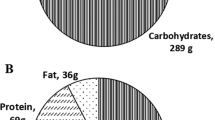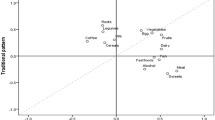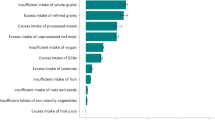Abstract
First Nations populations in Northwestern Ontario have undergone profound dietary and lifestyle transformations in less than 50 years, which have contributed to the alarming rise in obesity and obesity-related diseases, in particular type 2 diabetes mellitus. Even though the genetic background of First Nations peoples differs from that of the Caucasians, genetics alone cannot explain such a high prevalence in obesity and type 2 diabetes. Modifications in lifestyle and diet are major contributors for the high prevalence of chronic diseases. What remains constant in the literature is the persistent view that locally harvested and prepared foods are of tremendous value to First Nations peoples providing important health and cultural benefits that are increasingly being undermined by western-based food habits. However, the complexities of maintaining a traditional diet require a multifaceted approach, which acknowledges the relationship between benefits, risks and viability that cannot be achieved using purely conventional medical and biological approaches. This brief review explores the biological predispositions and potential environmental factors that contribute to the development of the high incidence of obesity and obesity-related diseases in First Nations communities in Northern Canada. It also highlights some of the complexities of establishing exact physiological causes and providing effective solutions.
This is a preview of subscription content, access via your institution
Access options
Subscribe to this journal
Receive 12 print issues and online access
$259.00 per year
only $21.58 per issue
Buy this article
- Purchase on Springer Link
- Instant access to full article PDF
Prices may be subject to local taxes which are calculated during checkout


Similar content being viewed by others
References
Organization NAH. First Nations and Inuit Regional Health Surveys, 1997: A Synthesis of the National and Regional Reports. National Aboriginal Health Organization: Ottawa, 2004.
Young TK, Reading J, Elias J, O'Neil JD . Type 2 diabetes mellitus in Canada's First Nations: status of an epidemic in progress. CMAJ 2000; 163: 561–566.
Gittelsohn J, Wolever TM, Harris SB, Harris-Giraldo R, Hanley AJ, Zinman B . Specific patterns of food consumption and preparation are associated with diabetes and obesity in a native Canadian community. J Nutr 1998; 128: 541–547.
Harris S, Gittelsohn J, Hanley A, Barnie A, Wolever T, Gao J et al. The prevalence of NIDDM and associated risk factors in native Canadians. Diabetes Care 1997; 20: 185–187.
Katzmarzyk PT, Malina RM . Obesity and relative subcutaneous fat distribution among Canadians of First Nation and European ancestry. Int J Obes Relat Metab Disord 1998; 22: 1127–1131.
Katzmarzyk PT . Obesity and physical activity among aboriginal Canadians. Obesity 2008; 16: 184–190.
Kriska AM, Hanley AJG, Harris SB, Zinman B . Physical activity, physical fitness, and insulin and glucose concentrations in an isolated native Canadian population experiencing rapid lifestyle change. Diabetes Care 2001; 24: 1787–1792.
Liu J, Young TK, Zinman B, Harris SB, Connelly PW, Hanley AJG . Lifestyle variables, non-traditional cardiovascular risk factors, and the metabolic syndrome in an aboriginal Canadian population. Obesity 2006; 14: 500–508.
Batal M, Gray-Donald K, Kuhnlein HV, Receveur O . Estimation of traditional food intake in indigenous communities in Denendeh and the Yukon. Int J Circumpolar Health 2005; 64: 46–54.
Hoffmann A, Willi Y . Detecting genetic responses to environmental change. Nat Rev Genet 2008; 9: 421–432.
Kuhnlein HV, Soueida R, Receveur O . Dietary nutrient profiles of Canadian Baffin Island Inuit differ by food source, season, and age. J Am Diet Assoc 1996; 96: 155–162.
Kwon YI, Apostolidis E, Kim YC, Shetty K . Health benefits of traditional corn, beans, and pumpkin: in vitro studies for hyperglycemia and hypertension management. J Med Food 2007; 10: 266–275.
Robidoux MA, Haman F, Sethna C . The relationship of the burbot (Lota lota L.) to the reintroduction of off-the-land foods in the Sandy Lake First Nation Community. Biodemography Soc Biol 2009; 55: 12–29.
Appavoo D, Kubow S, Kuhnlein HV . Lipid composition of indigenous foods eaten by the Suhtu (Hareskin) Dene/Métis of the Northwest Territories. J Food Compost Anal 1991; 4: 108–120.
Belinsky DK . HV macronutrient, mineral, and fatty acid composition of Canada Goose (Branta canadensis): an important traditional food resource of the Eastern James Bay Cree of Quebec. J Food Compost Anal 2000; 13: 101–115.
Wein E . Nutrient intakes of First Nations people in four Yukon communities. Nutr Res 1995; 15: 1105–1119.
Receveur O, Boulay M, Kuhnlein HV . Decreasing traditional food use affects diet quality for adult Dene/Metis in 16 communities of the Canadian Northwest Territories. J Nutr 1997; 127: 2179–2186.
Nakano T, Fediuk K, Kassi N, Egeland GM, Kuhnlein HV . Dietary nutrients and anthropometry of Dene/Metis and Yukon children. Int J Circumpolar Health 2005; 64: 147–156.
Kuhnlein HV, Receveur O . Local cultural animal food contributes high levels of nutrients for Arctic Canadian Indigenous adults and children. J Nutr 2007; 137: 1110–1114.
Kuhnlein H, Chan HM, Leggee D, Barthet V . Macronutrient, mineral and fatty acid composition of Canadian Arctic traditional food. J Food Compost Anal 2002; 15: 545–566.
Blanchet C, Dewailly E, Ayotte P, Bruneau S, Receveur O, Holub BJ . Contribution of selected traditional and market foods to the diet of Nunavik Inuit women. Can J Diet Pract Res 2000; 61: 50–59.
Das UN . Beneficial effect(s) of n-3 fatty acids in cardiovascular diseases: but, why and how? Prostaglandins Leukot Essent Fatty Acids 2000; 63: 351–362.
Berti PR, Soueida R, Kuhnlein HV . Dietary assessment of indigenous Canadian Arctic women with a focus on pregnancy and lactation. Int J Circumpolar Health 2008; 67: 349–362.
Kuhnlein HV, Receveur O, Soueida R, Berti PR . Unique patterns of dietary adequacy in three cultures of Canadian Arctic indigenous peoples. Public Health Nutr 2008; 11: 349–360.
Campbell ML, Diamant RM, Macpherson BD, Halladay JL . The contemporary food supply of three Northern Manitoba Cree communities. Can J Public Health 1997; 88: 105–108.
Gittelsohn J, Wolever TMS, Harris SB, Harris-Giraldo R, Hanley AJG, Zinman B . Specific patterns of food consumption and preparation are associated with diabetes and obesity in a Native Canadian community. J Nutr 1998; 128: 541–547.
deGonzague B, Receveur O, Wedll D, Kuhnlein HV . Dietary intake and body mass index of adults in 2 Ojibwe communities. J Am Diet Assoc 1999; 99: 710–716.
Kuhnlein HV . Karat, pulque, and gac: three shining stars in the traditional food galaxy. Nutr Rev 2004; 62: 439–442.
Batal M, Gray-Donald K, Kuhnlein HV, Receveur O . Estimation of traditional food intake in indigenous communities in Denendeh and the Yukon. Int J Circumpolar Health 2005; 64: 46–54.
Nakano T, Fediuk K, Kassi N, Kuhnlein HV . Food use of Dene/Metis and Yukon children. Int J Circumpolar Health 2005; 64: 137–146.
Young TK . The Health of Native Americans: Toward a Biocultural Epidemiology. Oxford University Press: New York, 1994.
Szathmary FJ, Ritenbaugh C, Goodby CS . Dietary change and plasma glucose levels in Amerindian population undergoing cultural transition. Soc Sci Med 1987; 24: 791–804.
Bruce S . The impact of diabetes mellitus among the Metis of Western Canada. Ethn Health 2000; 5: 47–57.
Johnson SM, Martin D, Sarin C . Diabetes mellitus in the First Nations population of British Columbia, Canada. Part 3. Prevalence of diagnosed cases. Int J Circumpolar Health 2002; 61: 260–264.
Hegele R, Connelly PW, Hanley AJ, Sun F, Harris SB, Zinman B . Common genomic variants associated with variation in plasma lipoproteins in young aboriginal Canadians. Arterioscler Thromb Vasc Biol 1997; 17: 1060–1066.
Daniel M, Rowley KG, Herbert CP, O'Dea K, Green LW . Lipids and psychosocial status in aboriginal persons with and at risk for type 2 diabetes: implications for tertiary prevention. Patient Educ Couns 2001; 43: 85–95.
Anand SS, Yusuf S, Jacobs R, Davis AD, Yi Q, Gerstein H et al. Risk factors, atherosclerosis, and cardiovascular disease among Aboriginal people in Canada: the Study of Health Assessment and Risk Evaluation in Aboriginal Peoples (SHARE-AP). Lancet 2001; 358: 1147–1153.
Hegele R . Genetic prediction of atherosclerosis: lessons from studies in native Canadian populations. Clin Chim Acta 1999; 286: 47–61.
Hegele R, Cao H, Harris SB, Hanley AJ, Zinman B . The hepatic nuclear factor-1alpha G319S variant is associated with early-onset type 2 diabetes in Canadian Oji-Cree. J Clin Endocrinol Metab 1999; 84: 1077–1082.
Hegele R . Genes and environment in type 2 diabetes and atherosclerosis in aboriginal Canadians. Curr Atheroscler Rep 2001; 3: 216–221.
Hegele R, Zinman B, Hanley AJ, Harris SB, Barrett PH, Cao H . Genes, environment and Oji-Cree type 2 diabetes. Clin Biochem 2003; 36: 163–170.
Yotova V, Labuda D, Zietkiewicz E, Gehl D, Lovell A, Lefebvre JF et al. Anatomy of a founder effect: myotonic dystrophy in Northeastern Quebec. Hum Genet 2005; 117: 177–187.
Corella D, Ordovas JM . Single nucleotide polymorphisms that influence lipid metabolism: interaction with dietary factors. Annu Rev Nutr 2005; 25: 341–391.
Hegele R, Cao H, Harris SB, Zinman B, Hanley AJ, Anderson CM . Peroxisome proliferator-activated receptor-gamma2 P12A and type 2 diabetes in Canadian Oji-Cree. J Clin Endocrinol Metab 2000; 85: 2014–2019.
Deeb S, Fajas L, Nemoto M, Pihlajamäki J, Mykkänen L, Kuusisto J et al. A Pro12Ala substitution in PPARgamma2 associated with decreased receptor activity, lower body mass index and improved insulin sensitivity. Nat Genet 1998; 20: 284–287.
Robitaille J, Després JP, Pérusse L, Vohl MC . The PPAR-gamma P12A polymorphism modulates the relationship between dietary fat intake and components of the metabolic syndrome: results from the Québec Family Study. Clin Genet 2003; 63: 109–116.
Luan J, Browne PO, Harding AH, Halsall DJ, O'Rahilly S, Chatterjee VK et al. Evidence for gene-nutrient interaction at the PPARgamma locus. Diabetes 2001; 50: 686–689.
Hegele R, Harris SB, Hanley AJ, Sadikian S, Connelly PW, Zinman B . Genetic variation of intestinal fatty acid-binding protein associated with variation in body mass in aboriginal Canadians. J Clin Endocrinol Metab 1996; 81: 4334–4337.
Chamberlain A, Schreiner PJ, Fornage M, Loria CM, Siscovick D, Boerwinkle E . Ala54Thr polymorphism of the fatty acid binding protein 2 gene and saturated fat intake in relation to lipid levels and insulin resistance: the Coronary Artery Risk Development in Young Adults (CARDIA) study. Metabolism 2009; 58: 1222–1228.
Masson L, McNeill G, Avenell A . Genetic variation and the lipid response to dietary intervention: a systematic review. Am J Clin Nutr 2003; 77: 1098–1111.
Gross LS, Li L, Ford ES, Liu S . Increased consumption of refined carbohydrates and the epidemic of type 2 diabetes in the United States: an ecologic assessment. Am J Clin Nutr 2004; 79: 774–779.
Lopez-Garcia E, Schulze MB, Fung TT, Meigs JB, Rifai N, Manson JE et al. Major dietary patterns are related to plasma concentrations of markers of inflammation and endothelial dysfunction. Am J Clin Nutr 2004; 80: 1029–1035.
Harris SB, Zinman B, Hanley A, Gittelsohn J, Hegele R, Connelly PW et al. The impact of diabetes on cardiovascular risk factors and outcomes in a native Canadian population. Diabetes Res Clin Pract 2002; 55: 165–173.
Health Canada. Canada's Food Guide to Healthy Eating. In: Minister of Public Works and Government Services Canada (ed.), Government of Canada: Canada, 1997.
Berkes F, George PJ, Preston RJ, Cummins BD, Turner J . The persistence of aboriginal land use: fish and wildlife harvest areas in Hudson and James Bay lowland, Ontario. Arctic 1995; 48: 81–93.
Lawn J, Harvey D, Hill F, Brulé D . An update on nutrition surveys in isolgated northern communities. In: Health Canada (ed.), Government of Canada: Canada, 2002.
Wagner MW . Domestic hunting and fishing by Manitoba Indians: magnitude, compostion and implications for management. Can J Native Studies 1986; 6: 105–120.
Hayes M, Chustek M, Heshka S, Wang Z, Pietrobelli A, Heymsfield SB . Low physical activity levels of modern Homo sapiens among free-ranging mammals. Int J Obes (Lond) 2005; 29: 151–156.
Indian and Northern Affairs Canada. Northern Contaminants Program: Canadian Arctic Contaminants and Health Assessment Report. 2009.
Cruz García GS . The mother–child nexus. Knowledge and valuation of wild food plants in Wayanad, Western Ghats, India. J Ethnobiol Ethnomed 2006; 2: 39.
Wilken GC . Drained-field agriculture: an intensive farming system in Tlaxcala, Mexico. Geogr Rev 1969; 59: 215–241.
Dewailly R, Blanchet C, Gingras S, Lemieux S, Holub BJ . Cardiovascular disease risk factors and n-3 fatty acid status in the adult population of James Bay Cree. Am J Clin Nutr 2002; 76: 85–92.
Courval JM, DeHoog JV, Stein AD, Tay EM, He JP, Humphrey HEB et al. Sport-caught fish consumption and conception delay in licensed Michigan anglers. Environ Res 1999; 80: 183–188.
Jacobson JL, Jacobson SW . Intellectual impairment in children exposed to polychlorinated biphenyls in utero. N Engl J Med 1996; 335: 783–789.
Moysich KB, Baker JA, Freudenheim JL, Ambrosone CB, Bowman E, Schisterman EF et al. Apolipoprotein E polymorphism, serum triglycerides and breast cancer risk. Epidemiology 1999; 10: 84–84.
Feeley M, Grant D . Approach to risk assessment of PCDDs anad PCDFs in Canada. Regul Pharmacol Toxicol 1993; 18: 428–437.
Rolaf van Leeuwen FXY, M M . Consultation on assessment of health risks of dioxins; reevalation of the tolerable daily intake (TDI) Executive Summary. Food Addit Contam 2000; 17: 223–240.
Dewailly E, Mulvad G, Pedersen HS, Ayotte P, Demers A, Weber JP et al. Concentration of organochlorines in human brain, liver, and adipose tissue autopsy samples from Greenland. Environ Health Perspect 1999; 107: 823–828.
Pelletier C, Imbeault P, Tremblay A . Energy balance and pollution by organochlorines and polychlorinated biphenyls. Obes Rev 2003; 4: 17–24.
Jung D, Becher H, Edler L, Flesch-Janys D, Gurn P, Konietzko J et al. Elimination of beta-hexachlorocyclohexane in occupationally exposed persons. J Toxicol Environ Health 1997; 51: 23–34.
Schildkraut JM, Demark-Wahnefried W, DeVoto E, Hughes C, Laseter JL, Newman B . Environmental contaminants and body fat distribution. Cancer Epidemiol Biomarkers Prev 1999; 8: 179–183.
Hennig B, Reiterer G, Majkova Z, Oesterling E, Meerarani P, Toborek M . Modification of environmental toxicity by nutrients: implications in atherosclerosis. Cardiovasc Toxicol 2005; 5: 153–160.
Matsumura F . The significance of the nongenomic pathway in mediating inflammatory signaling of the dioxin-activated Ah receptor to cause toxic effects. Biochem Pharmacol 2009; 77: 608–626.
Codru N, Schymura MJ, Negoita S, Rej R, Carpenter DO . Diabetes in relation to serum levels of polychlorinated biphenyls and chlorinated pesticides in adult native Americans. Environ Health Perspect 2007; 115: 1442–1447.
Everett CJ, Frithsen IL, Diaz VA, Koopman RJ, Simpson Jr WM, Mainous III AG . Association of a polychlorinated dibenzo-p-dioxin, a polychlorinated biphenyl, and DDT with diabetes in the 1999–2002 National Health and Nutrition Examination Survey. Environ Res 2007; 103: 413–418.
Fierens S, Mairesse H, Heilier JF, De Burbure C, Focant JF, Eppe G et al. Dioxin/polychlorinated biphenyl body burden, diabetes and endometriosis: findings in a population-based study in Belgium. Biomarkers 2003; 8: 529–534.
Lee DH, Lee IK, Steffes M, Jacobs Jr DR . Extended analyses of the association between serum concentrations of persistent organic pollutants and diabetes. Diabetes Care 2007; 30: 1596–1598.
Rignell-Hydbom A, Rylander L, Hagmar L . Exposure to persistent organochlorine pollutants and type 2 diabetes mellitus. Hum Exp Toxicol 2007; 26: 447–452.
Uemura H, Arisawa K, Hiyoshi M, Satoh H, Sumiyoshi Y, Morinaga K et al. Associations of environmental exposure to dioxins with prevalent diabetes among general inhabitants in Japan. Environ Res 2008; 108: 63–68.
Cox S, Niskar AS, Narayan KM, Marcus M . Prevalence of self-reported diabetes and exposure to organochlorine pesticides among Mexican Americans: hispanic health and nutrition examination survey, 1982–1984. Environ Health Perspect 2007; 115: 1747–1752.
Turyk M, Anderson H, Knobeloch L, Imm P, Persky V . Organochlorine exposure and incidence of diabetes in a cohort of Great Lakes sport fish consumers. Environ Health Perspect 2009; 117: 1076–1082.
Turyk M, Anderson HA, Knobeloch L, Imm P, Persky VW . Prevalence of diabetes and body burdens of polychlorinated biphenyls, polybrominated diphenyl ethers, and p,p'-diphenyldichloroethene in Great Lakes sport fish consumers. Chemosphere 2009; 75: 674–679.
Rignell-Hydbom A, Lidfeldt J, Kiviranta H, Rantakokko P, Samsioe G, Agardh CD et al. Exposure to p,p'-DDE: a risk factor for type 2 diabetes. PLoS One 2009; 4: e7503.
Author information
Authors and Affiliations
Corresponding author
Ethics declarations
Competing interests
The authors declare no conflict of interest.
Rights and permissions
About this article
Cite this article
Haman, F., Fontaine-Bisson, B., Batal, M. et al. Obesity and type 2 diabetes in Northern Canada's remote First Nations communities: the dietary dilemma. Int J Obes 34 (Suppl 2), S24–S31 (2010). https://doi.org/10.1038/ijo.2010.236
Published:
Issue Date:
DOI: https://doi.org/10.1038/ijo.2010.236
Keywords
This article is cited by
-
Exploring structural barriers to diabetes self-management in Alberta First Nations communities
Diabetology & Metabolic Syndrome (2018)
-
Community perspectives on food insecurity and obesity: Focus groups with caregivers of Métis and Off-reserve First Nations children
International Journal for Equity in Health (2015)
-
Association of red blood cell n-3 polyunsaturated fatty acids with plasma inflammatory biomarkers among the Quebec Cree population
European Journal of Clinical Nutrition (2014)
-
Dietary practices in isolated First Nations communities of northern Canada: combined isotopic and lipid markers provide a good qualitative assessment of store-bought vs locally harvested foods consumption
Nutrition & Diabetes (2013)
-
What is the comparative health status and associated risk factors for the Métis? A population-based study in Manitoba, Canada
BMC Public Health (2011)



